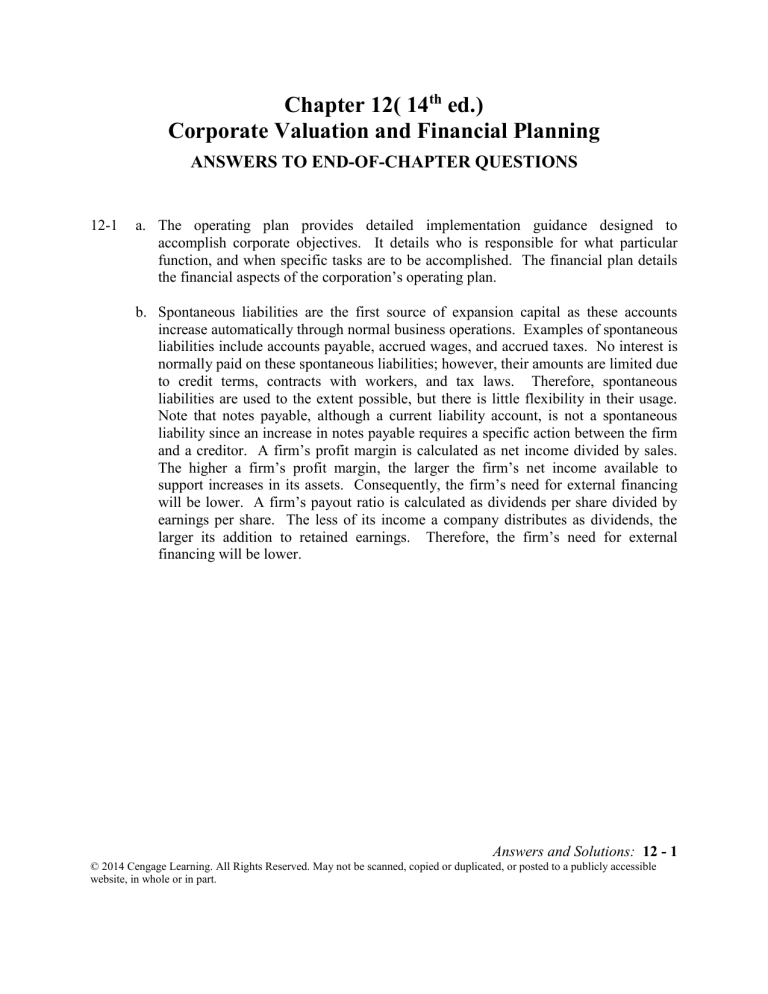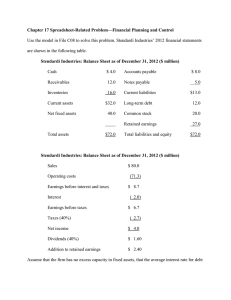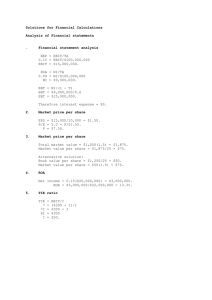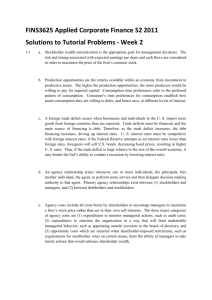
Chapter 12( 14th ed.)
Corporate Valuation and Financial Planning
ANSWERS TO END-OF-CHAPTER QUESTIONS
12-1
a. The operating plan provides detailed implementation guidance designed to
accomplish corporate objectives. It details who is responsible for what particular
function, and when specific tasks are to be accomplished. The financial plan details
the financial aspects of the corporation’s operating plan.
b. Spontaneous liabilities are the first source of expansion capital as these accounts
increase automatically through normal business operations. Examples of spontaneous
liabilities include accounts payable, accrued wages, and accrued taxes. No interest is
normally paid on these spontaneous liabilities; however, their amounts are limited due
to credit terms, contracts with workers, and tax laws. Therefore, spontaneous
liabilities are used to the extent possible, but there is little flexibility in their usage.
Note that notes payable, although a current liability account, is not a spontaneous
liability since an increase in notes payable requires a specific action between the firm
and a creditor. A firm’s profit margin is calculated as net income divided by sales.
The higher a firm’s profit margin, the larger the firm’s net income available to
support increases in its assets. Consequently, the firm’s need for external financing
will be lower. A firm’s payout ratio is calculated as dividends per share divided by
earnings per share. The less of its income a company distributes as dividends, the
larger its addition to retained earnings. Therefore, the firm’s need for external
financing will be lower.
Answers and Solutions: 12 - 1
© 2014 Cengage Learning. All Rights Reserved. May not be scanned, copied or duplicated, or posted to a publicly accessible
website, in whole or in part.
c. Additional funds needed (AFN) are those funds required from external sources to
increase the firm’s assets to support a sales increase. A sales increase will normally
require an increase in assets. However, some of this increase is usually offset by a
spontaneous increase in liabilities as well as by earnings retained in the firm. Those
funds that are required but not generated internally must be obtained from external
sources. Although most firms’ forecasts of capital requirements are made by
developing forecasted financial statements, the AFN formula is sometimes used as an
approximation of financial requirements. It is written as follows:
Additional
funds
needed
AFN
=
Required
asset
increase
–
=
(A0*/S0)S
–
Increase in
spontaneou s –
liab.
(L0*/S0)S –
Increase in
retained
earnings
MS1(1 – Payout rate)
Capital intensity is the dollar amount of assets required to produce a dollar of sales.
The capital intensity ratio is the reciprocal of the total assets turnover ratio. It is
calculated as Assets/Sales. The sustainable growth rate is the maximum growth rate
the firm could achieve without having to raise any external capital. A firm’s selfsupporting growth rate can be calculated as follows:
Self-supporting g =
M(1 POR)(S0 )
A 0 * L 0 * M(1 POR)(S0 )
d. The forecasted financial statement approach using percent of sales develops a
complete set of financial statements that can be used to calculate projected EPS, free
cash flow, various other financial ratios, and a projected stock price. This approach
first forecasts sales, the required assets, the funds that will be spontaneously
generated, and then net income, dividends, and retained earnings.
e. A firm has excess capacity when its sales can grow before it must add fixed assets
such as plant and equipment. “Lumpy” assets are those assets that cannot be acquired
smoothly, but require large, discrete additions. For example, an electric utility that is
operating at full capacity cannot add a small amount of generating capacity, at least
not economically. When economies of scale occur, the ratios are likely to change
over time as the size of the firm increases. For example, retailers often need to
maintain base stocks of different inventory items, even if current sales are quite low.
As sales expand, inventories may then grow less rapidly than sales, so the ratio of
inventory to sales declines.
Answers and Solutions: 12 - 2
© 2014 Cengage Learning. All Rights Reserved. May not be scanned, copied or duplicated, or posted to a publicly accessible
website, in whole or in part.
f. Full capacity sales are calculated as actual sales divided by the percentage of capacity
at which fixed assets were operated. The target fixed assets to sales ratio is calculated
as actual fixed assets divided by full capacity sales. The required level of sales is
calculated as the target fixed assets to sales ratio multiplied by the projected sales
level.
12-2
Accounts payable, accrued wages, and accrued taxes increase spontaneously. Retained
earnings may or may not increase, depending on profitability and dividend payout policy.
12-3
The equation gives good forecasts of financial requirements if the ratios A0*/S and L0*/S,
the profit margin, and payout ratio are stable. This equation assumes that ratios are
constant. This would not occur if there were economies of scale, excess capacity, or
when lumpy assets are required. Otherwise, the forecasted financial statement method
should be used.
12-4
The five key factors that impact a firm’s external financing requirements are: Sales
growth, capital intensity, spontaneous liabilities-to-sales ratio, profit margin, and payout
ratio.
12-5
The self-supporting growth rate is the maximum rate a firm can achieve without having
to raise external capital. The self-supporting growth rate is calculated using the AFN
equation, setting AFN equal to zero, replacing the term ΔS with the term g × S 0, and
replacing the term S1 with S0 × (1 + g). Once the AFN equation is rewritten with these
modifications, you can now solve for g. This “g” obtained is the firm’s self-supporting
growth rate.
12-6
a. +.
b. +. It reduces spontaneous funds; however, it may eventually increase retained
earnings.
c. +.
d. +.
e. –.
f. –.
Answers and Solutions: 12 - 3
© 2014 Cengage Learning. All Rights Reserved. May not be scanned, copied or duplicated, or posted to a publicly accessible
website, in whole or in part.
SOLUTIONS TO END-OF-CHAPTER PROBLEMS
12-1
12-2
AFN = (A0*/S0)∆S – (L0*/S0)∆S – (PM)(S1)(1 – payout rate)
$5,000,000
$900,000
=
$1,200,000 –
$1,200,000 – 0.06($9,200,000)(1 – 0.4)
$8,000,000
$8,000,000
= (0.625)($1,200,000) – (0.1125)($1,200,000) – ($552,000)(0.6)
= $750,000 – $135,000 – $331,200
= $283,800.
$7,000,000
$900,000
AFN =
$1,200,000 –
$1,200,000 – 0.06($9,200,000)(1 – 0.4)
$8,000,000
$8,000,000
= (0.875)($1,200,000) – $135,000 – $331,200
= $1,050,000 – $466,200
= $583,800.
The capital intensity ratio is measured as A0*/S0. This firm’s capital intensity ratio is
higher than that of the firm in Problem 9-1; therefore, this firm is more capital
intensive—it would require a large increase in total assets to support the increase in
sales.
12-3
AFN = (0.625)($1,200,000) – (0.1125)($1,200,000) – 0.06($9,200,000)(1 – 0)
= $750,000 – $135,000 – $552,000
= $63,000.
Under this scenario the company would have a higher level of retained earnings
which would reduce the amount of additional funds needed.
Answers and Solutions: 12 - 4
© 2014 Cengage Learning. All Rights Reserved. May not be scanned, copied or duplicated, or posted to a publicly accessible
website, in whole or in part.
12-4
S0 = $5,000,000; A0* = $2,500,000; CL = $700,000; NP = $300,000; AP = $500,000;
Accruals = $200,000; M = 7%; payout ratio = 80%; A0*/S0 = 0.50; L0* = (AP +
Accruals)/S0 = ($500,000 + $200,000)/$5,000,000 = 0.14.
AFN = (A0*/S0)∆S – (L0*/S0)∆S – (M)(S1)(1 – payout rate)
= (0.50)∆S – (0.14) ∆S – (0.07)(S1)(1 – 0.8)
= (0.50)∆S – (0.14)∆S – (0.014)S1
= (0.36)∆S – (0.014)S1
= 0.36(S1 – S0) – (0.014)S1
= 0.36(S1 – $5,000,000) – (0.014)S1
= 0.36S1 – $1,800,000 – 0.014S1
$1,800,000 = 0.346S1
$5,202,312 = S1.
Sales can increase by $5,202,312 – $5,000,000 = $202,312 without additional funds
being needed.
12-5
a.
Total liab. = Accounts + Long -term + Common + Retained
payable
stock
earnings
and equity
debt
$2,170,000 = $560,000 + Long-term debt + $625,000 + $395,000
Long-term debt = $590,000.
Total liab. = Accounts payable + Long-term debt
= $560,000 + $590,000 = $1,150,000.
b. Assets/Sales (A0*/S0) = $2,170,000/$3,500,000 = 62%.
L0*/Sales = $560,000/$3,500,000 = 16%.
2014 Sales = (1.35)($3,500,000) = $4,725,000.
AFN = (A0*/S0)(∆S) – (L0*/S0)(∆S) – (M)(S1)(1 – payout) – New common stock
= (0.62)($1,225,000) - (0.16)($1,225,000) - (0.05)($4,725,000)(0.55) - $195,000
= $759,500 - $196,000 - $129,937 - $195,000 = $238,563.
Alternatively, using the forecasted financial statement method:
Answers and Solutions: 12 - 5
© 2014 Cengage Learning. All Rights Reserved. May not be scanned, copied or duplicated, or posted to a publicly accessible
website, in whole or in part.
Total assets
Current liabilities
Long-term debt
Total liabilities
Common stock
Retained earnings
Total common equity
Total liabilities
and equity
2013
$2,170,000
$ 560,000
590,000
$ 1,150,000
625,000
395,000
$ 1,020,000
Forecast
Basis %
2014 Sales
0.62
0.16
Additions (New
Financing, R/E)
195,000*
129,937**
$2,170,000
AFN = Additional long-term debt =
2,929,500 – 2,690,937 =
2014
$2,929,500
$ 756,000
590,000
$ 1,346,000
820,000
524,937
$ 1,344,937
$2,690,937
$ 238,563
*Given in problem that firm will sell new common stock = $195,000.
**PM = 5%; Payout = 45%; NI2014 = $3,500,000 x 1.35 x 0.05 = $236,250.
Addition to RE = NI x (1 - Payout) = $236,250 x 0.33 = $129,937.
Answers and Solutions: 12 - 6
© 2014 Cengage Learning. All Rights Reserved. May not be scanned, copied or duplicated, or posted to a publicly accessible
website, in whole or in part.
12-6
Cash
Accounts receivable
Inventories
Net fixed assets*
Total assets
$ 100.00
200.00
200.00
500.00
$1,000.00
2.0
2.0
2.0
1.0
=
=
=
=
$ 200.00
400.00
400.00
500.00
$1,500.00
Accounts payable
Accruals
Notes payable
Long-term debt
Common stock
Retained earnings**
Total liabilities
and equity
$
+
+
+
+
2
2
0
0
0
40
=
=
=
=
=
=
$ 100.00
100.00
150.00
400.00
100.00
290.00
50.00
50.00
150.00
400.00
100.00
250.00
$1,000.00
$1,140.00
AFN = $ 360.00
*Capacity sales = Sales/0.5 = $1,000/0.5 = $2,000 with respect to existing fixed assets.
Target FA/S ratio = $500/$2,000 = 0.25.
Target FA = 0.25($2,000) = $500 = Required FA. Since the firm currently has $500 of
fixed assets, no new fixed assets will be required.
**Addition to RE = (M)(S1)(1 – Payout ratio) = 0.05($2,000)(0.4) = $40.
12-7
a. AFN = (A0*/S0)(S) – (L0*/S0)(S) – (M)(S1)(1 – payout)
$122.5
$17.5
$10.5
=
($70) –
($70) –
($420)(0.6) = $13.44 million.
$350
$350
$350
b.
Self-supporting g =
=
M(1 POR)(S0 )
A 0 * L 0 * M(1 POR)(S0 )
0.03(1 0.40)( 350)
122.5 17.5 .03(1 .4)( 350)
= 6.38%
Answers and Solutions: 12 - 7
© 2014 Cengage Learning. All Rights Reserved. May not be scanned, copied or duplicated, or posted to a publicly accessible
website, in whole or in part.
c.
Upton Computers
Pro Forma Balance Sheet
December 31, 2014
(Millions of Dollars)
Cash
Receivables
Inventories
Total current assets
Net fixed assets
Total assets
Accounts payable
Notes payable
Line of credit
Accruals
Total current liabilities
Mortgage loan
Common stock
Retained earnings
Total liab. and equity
2013
$ 3.5
26.0
58.0
$ 87.5
35.0
$122.5
$
9.0
18.0
0.0
8.5
$ 35.5
6.0
15.0
66.0
$122.5
Forecast
Basis %
2014 Sales
0.0100
0.0743
0.1657
Additions
0.100
0.0257
0.0243
7.56*
2014 Pro
Forma
$ 4.20
31.20
69.60
$105.00
42.00
$147.00
$ 10.80
18.00
0.00
10.20
$ 39.00
6.00
15.00
73.56
$133.56
Financing
+13.44
2014 Pro
Forma after
Financing
$ 4.20
31.20
69.60
$105.00
42.00
$147.00
$ 10.80
18.00
+13.44
10.20
$ 52.44
6.00
15.00
73.56
$147.00
Deficit =
$ 13.44
*M = $10.5/$350 = 3%.
Payout = $4.2/$10.5 = 40%.
NI = $350 1.2 0.03 = $12.6.
Addition to RE = NI – DIV = $12.6 – 0.4($12.6) = 0.6($12.6) = $7.56.
Answers and Solutions: 12 - 8
© 2014 Cengage Learning. All Rights Reserved. May not be scanned, copied or duplicated, or posted to a publicly accessible
website, in whole or in part.
12-8
Stevens Textiles
Pro Forma Income Statement
December 31, 2014
(Thousands of Dollars)
a.
Sales
Operating costs
EBIT
Interest
EBT
Taxes (40%)
Net income
2013
$36,000
32,440
$ 3,560
460
$ 3,100
1,240
$ 1,860
Dividends (45%)
Addition to RE
$ 837
$ 1,023
2014
Forecast
Basis
1.15 Sales13
0.9011 Sales14
0.10 × Debt13
2014
Pro Forma
$41,400
37,306
$ 4,094
560
$ 3,534
1,414
$ 2,120
$ 954
$ 1,166
Answers and Solutions: 12 - 9
© 2014 Cengage Learning. All Rights Reserved. May not be scanned, copied or duplicated, or posted to a publicly accessible
website, in whole or in part.
Stevens Textiles
Pro Forma Balance Sheet
December 31, 2014
(Thousands of Dollars)
Cash
Accts receivable
Inventories
Total curr. assets
Fixed assets
Total assets
2013
$ 1,080
6,480
9,000
$16,560
12,600
$29,160
Accounts payable
Accruals
Line of credit
Notes payable
Total curr. liabilities
Long-term debt
Total debt
Common stock
Retained earnings
Total liab. and equity
$ 4,320
2,880
0
2,100
$ 9,300
3,500
$12,800
3,500
12,860
$29,160
Forecast
Basis %
2014 Sales
0.0300
0.1800
0.2500
Additions
0.3500
0.1200
0.0800
1,166*
Deficit =
2014 Pro
Forma
$ 1,242
7,452
10,350
$19,044
14,490
$33,534
$ 4,968
3,312
0
2,100
$10,380
3,500
$13,880
3,500
14,026
$31,406
$ 2,128
2014
Financing
+2,128
2014 Pro
Forma after
Financing
$ 1,242
7,452
10,350
$19,044
14,490
$33,534
$ 4,968
3,312
+2,128
+2,128
$12,508
3,500
$16,008
3,500
14,026
$33,534
*From income statement.
b.
Line of credit = $2,128 (thousands of $).
c.
If debt is added throughout the year rather than only at the end of the year, interest
expense will be higher than in the projections of part a. This would cause net income to
be lower, the addition to retained earnings to be higher, and the AFN to be higher. Thus,
you would have to add more than $2,228 in new debt. This is called the financing
feedback effect.
Answers and Solutions: 12 - 10
© 2014 Cengage Learning. All Rights Reserved. May not be scanned, copied or duplicated, or posted to a publicly accessible
website, in whole or in part.
12-9
Garlington Technologies Inc.
Pro Forma Income Statement
December 31, 2014
Sales
Operating costs
EBIT
Interest
EBT
Taxes (40%)
Net income
2013
$3,600,000
3,279,720
$ 320,280
18,280
$ 302,000
120,800
$ 181,200
Dividends:
Addition to RE:
$ 108,000
$ 73,200
Forecast
Basis
1.10 Sales13
0.911 Sales14
0.13 × Debt13
Set by management
Pro Forma
2014
$3,960,000
3,607,692
$ 352,308
20,280
$ 332,028
132,811
$ 199,217
$ 112,000
$ 87,217
Garlington Technologies Inc.
Pro Forma Balance Statement
December 31, 2014
2013
Cash
Receivables
Inventories
Total curr. assets
Fixed assets
Total assets
Forecast
Basis %
2014 Sales
$ 180,000
360,000
720,000
$1,260,000
1,440,000
$2,700,000
0.05
0.10
0.20
Accounts payable
$ 360,000
Notes payable
156,000
Line of credit
0
Accruals
180,000
Total curr. liabilities $ 696,000
Common stock
1,800,000
Retained earnings
204,000
Total liab.
and equity
$2,700,000
0.10
0.40
0.05
Additions
2014
$ 198,000
396,000
792,000
$1,386,000
1,584,000
$2,970,000
$ 396,000
156,000
0
198,000
$ 750,000
1,800,000
87,217* 291,217
$2,841,217
AFN
Effects
With AFN
2014
$ 198,000
396,000
792,000
$1,386,000
1,584,000
$2,970,000
$ 396,000
156,000
+128,783128,783
198,000
$ 878,783
1,800,000
291,217
$2,970,000
Deficit = $ 128,783
*See income statement.
Answers and Solutions: 12 - 11
© 2014 Cengage Learning. All Rights Reserved. May not be scanned, copied or duplicated, or posted to a publicly accessible
website, in whole or in part.
SOLUTION TO SPREADSHEET PROBLEMS
12-10 The detailed solution is available in the file Ch12 P10 Build a Model Solution.xls at the
textbook’s Web site.
12-11 The detailed solution for is available in the file Ch12 P10 Build a Model Solution.xls at
the textbook’s Web site.
Answers and Solutions: 12 - 12
© 2014 Cengage Learning. All Rights Reserved. May not be scanned, copied or duplicated, or posted to a publicly accessible
website, in whole or in part.
Mini Case: 12 - 13
© 2014 Cengage Learning. All Rights Reserved. May not be scanned, copied or duplicated, or posted to a publicly accessible
website, in whole or in part.






